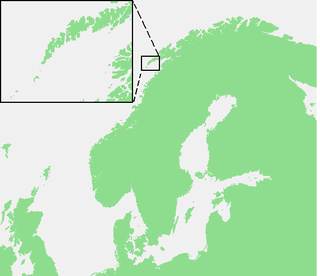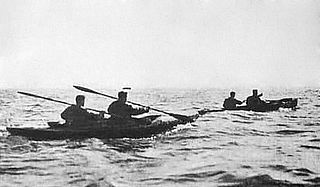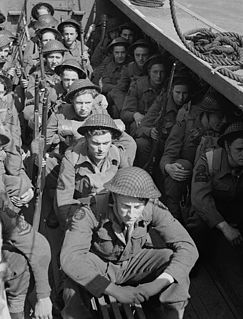Related Research Articles

A commando is a combatant, or operative of an elite light infantry or special operations force using dedicated operation techniques.

The Commandos, also known as the British Commandos, were formed during the Second World War in June 1940, following a request from the Prime Minister of the United Kingdom, Winston Churchill, for a force that could carry out raids against German-occupied Europe. Initially drawn from within the British Army from soldiers who volunteered for the Special Service Brigade, the Commandos' ranks would eventually be filled by members of all branches of the British Armed Forces and a number of foreign volunteers from German-occupied countries. By the end of the war 25,000 men had passed through the Commando course at Achnacarry. This total includes not only the British volunteers, but volunteers from Greece, France, Belgium, Netherlands, Canada, Norway, Poland, and the United States Army Rangers and US Marine Corps Raiders, which were modelled on the Commandos.
Layforce was an ad hoc military formation of the British Army consisting of a number of commando units during the Second World War. Formed in February 1941 under the command of Colonel Robert Laycock, after whom the force was named, it consisted of approximately 2,000 men and served in the Middle Eastern theatre of operations. Initially tasked with conducting raiding operations to disrupt Axis lines of communication in the Mediterranean it was planned that they would take part in operations to capture the Greek island of Rhodes.
The Commando Order was issued by the OKW, the high command of the German armed forces, on 18 October 1942. This order stated that all Allied commandos encountered in Europe and Africa should be killed immediately without trial, even if in proper uniforms or if they attempted to surrender. Any commando or small group of commandos or a similar unit, agents, and saboteurs not in proper uniforms who fell into the hands of the German forces by some means other than direct combat, were to be handed over immediately to the Sicherheitsdienst for execution.

Operation Archery, also known as the Måløy Raid, was a British Combined Operations raid during World War II against German positions on the island of Vågsøy, Norway, on 27 December 1941.

Operation Basalt was a small British raid conducted during World War II on Sark during the German occupation of the Channel Islands.

Operation Anklet was the codename given to a British Commando raid during the Second World War. The raid on the Lofoten Islands was carried out in December 1941, by 300 men from No. 12 Commando and the Norwegian Independent Company 1. The landing party was supported by 22 ships from three navies.

The Commandos Marine are the Special Operation Forces (SOF) of the French Navy. The Commandos Marine are nicknamed Bérets Verts. They operate under the Naval Riflemen and Special Operations Forces Command (FORFUSCO) and form part of the French Special Operations Command.

Beach Jumpers were U.S. Navy special warfare units organized during World War II by Lieutenant Douglas Fairbanks Jr.. They specialized in deception and psychological warfare. The units were active from 1943 to 1946 and 1951 to 1972.

Special forces and special operations forces (SOF) are military units trained to conduct special operations. NATO has defined special operations as "military activities conducted by specially designated, organized, trained, and equipped forces, manned with selected personnel, using unconventional tactics, techniques, and modes of employment".
No. 8 (Guards) Commando was a unit of the British Commandos and part of the British Army during the Second World War. The Commando was formed in June 1940 primarily from members of the Brigade of Guards. It was one of the units selected to be sent to the Middle East as part of Layforce. On arrival they became known as 'B' Battalion in an attempt at deception, not wanting the Axis forces to know there was a commando formation in the theatre of war. The commando participated in the Battle of Crete and around Tobruk before being disbanded in late 1941. After this, many of its personnel went on to serve in other commando units formed in the area, including the Special Air Service.
No. 7 Commando was a unit of the British Commandos and part of the British Army during the Second World War. The commando was formed in August 1940 in the United Kingdom. No. 7 Commando was transferred to the Middle East as part of Layforce. Committed to the Battle of Crete, it suffered heavy casualties, after which it was disbanded.
No. 50 Commando was a battalion-sized British Commando unit of the British Army during the Second World War. The commando was formed in 1940, from volunteers in Egypt and Palestine. Shortly after formation it was amalgamated with No. 52 Commando and became 'D' Battalion, Layforce.

The Commandos formed during the Second World War, following an order from the British Prime Minister Winston Churchill in June 1940 for a force that could carry out raids against German occupied Europe. Churchill stated in a minute to General Ismay on 6 June 1940: "Enterprises must be prepared, with specially-trained troops of the hunter class, who can develop a reign of terror down these coasts, first of all on the "butcher and bolt" policy..." Commandos were all volunteers for special service and originally came from the British Army but volunteers would eventually come from all branches of the United Kingdom's armed forces and foreign volunteers from countries occupied by the Germans. These volunteers formed over 30 individual units and four assault brigades.

Operation Checkmate was the codename for a raid on shipping at Haugesund, Norway in April 1943 during the Second World War by British Commandos. The raiding party consisted of seven men of No. 14 (Arctic) Commando who managed to sink one ship using limpet mines. While waiting in hiding for the transport back to the United Kingdom they were captured on 14 and 15 May 1943 and eventually taken to Sachsenhausen and Belsen concentration camps where six of them were executed, victims of the Commando Order. The seventh man died of typhus.

The Raid onBardia was an amphibious landing at the coastal town of Bardia in North Africa by British Commandos over the night of 19/20 April 1941 during the Second World War. The raid was carried out by No. 7 Commando also known as A Battalion Layforce together with a small detachment from the Royal Tank Regiment supported by five navy ships and a submarine. The raid—which destroyed an Italian artillery battery and a supply dump—was deemed a success despite the loss of 71 men. The more lasting strategic effect of the raid was the diversion of a German armoured brigade from the front line to provide rear area security.
The Twin Pimples Raid was a British Commando raid on a feature in the Italian lines during the siege of Tobruk in the Second World War. The raid, carried out by men of the No. 8 (Guards) Commando and the Royal Australian Engineers, was a complete success. However it did not end the siege; that continued until November 1941, when the Allied advance during Operation Crusader reached the town.

The Raid on Santorini took place on 24 April 1944 as part of the Mediterranean Campaign in World War II. It was conducted by the British Special Boat Service, against the mixed German and Italian garrison on the island of Santorini (Thera) in the Aegean Sea. The raid was made in tandem with similar operations at the islands of Ios, Mykonos and Amorgos that aimed to destroy Axis naval observation posts and radio stations on the Cycladic islands.
References
- ↑ "Naval codewords". Naval History. Retrieved 15 June 2010.